A European Union Association Agreement or simply Association Agreement (AA) is a treaty between the European Union, its Member States and a non-EU country or bloc of countries that governs bilateral relations. Areas frequently covered by such agreements include the development of political, trade, social, cultural and security links. The provision for an association agreement was included in the Treaty of Rome, which established the European Economic Community, as a means to enable co-operation of the Community with the United Kingdom, which had retreated from the treaty negotiations at the Messina Conference of 1955. According to the European External Action Service, for an agreement to be classified as an AA, it must meet several criteria:
1. The legal basis for [association agreements'] conclusion is Article 217 TFEU
2. Intention to establish close economic and political cooperation ;
3. Creation of paritary bodies for the management of the cooperation, competent to take decisions that bind the contracting parties;
4. Offering most favoured nation treatment;
5. Providing for a privileged relationship between the EC and its partner;
6. Since 1995 the clause on the respect of human rights and democratic principles is systematically included and constitutes an essential element of the agreement;
7. In a large number of cases, the association agreement replaces a cooperation agreement thereby intensifying the relations between the partners.
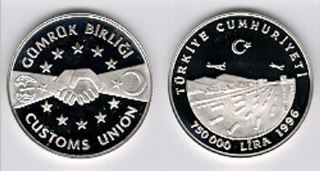
The European Union–Turkey Customs Union is a trade agreement between the European Union (EU) and Turkey. The agreement came into effect on 31 December 1995, following a 6 March 1995 decision of the European Community–Turkey Association Council to implement a customs union between the two parties. Goods may travel between the two entities without any customs restrictions. The Customs Union does not cover essential economic areas such as agriculture, services or public procurement.

The United States is party to many free trade agreements (FTAs) worldwide.
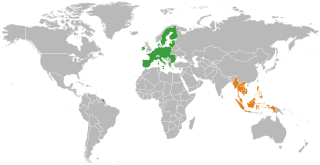
The ASEAN–European Union relations are the bilateral foreign relations between the two organisations; the European Union (EU), and the Association of Southeast Asian Nations (ASEAN). EU and ASEAN have been interacting with each other on the economic, trade, and political levels for more than four decades. The partnership between the EU and ASEAN dates back to 1972, when the EU established ties with ASEAN. The EU became an ASEAN Dialogue Partner in 1977.
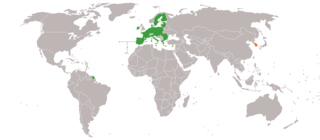
The European Union–South Korea Free Trade Agreement is a free trade agreement between the European Union (EU) and South Korea. The agreement was signed on 15 October 2009. The agreement was provisionally applied from 1 July 2011, and entered into force from 13 December 2015, after having been ratified by all signatories.

Relations between the European Union and the Republic of India are currently defined by the 1994 EU–India Cooperation Agreement. The EU is a significant trade partner for India and the two sides have been attempting to negotiate a free trade deal since 2007. Indo-EU bilateral trade stood at US$104.3 billion in the financial year 2018–19.
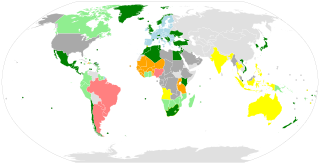
The European Union has concluded free trade agreements (FTAs) and other agreements with a trade component with many countries worldwide and is negotiating with many others. The European Union negotiates free trade deals on behalf of all of its member states, as the member states have granted the EU has an "exclusive competence" to conclude trade agreements. Even so, member states' governments control every step of the process :

Mexico and the European Economic Community (EEC) signed an agreement intending to foster economic and trade relations on 15 July 1975. Mexico and the European Union (EU) have had a free trade agreement since 2000 and the two benefit from high investment flows.

Relations between the European Union (EU) and Japan date back to 1959. They have a strong trade relationship, particularly in investment flows.

The European Union (EU) and South Korea are important trade partners: As of April 2023, Korea is the EU's third-largest importer. Excluding European countries, Korea has secured the third place on the list, following China and the United States. And the EU is Korea's third largest export destination. The two have signed a free trade agreement which came into effect at end of 2011. Furthermore, South Korea is the only country in the world with the three agreements covering economics, politics and security in effect as of 2020.
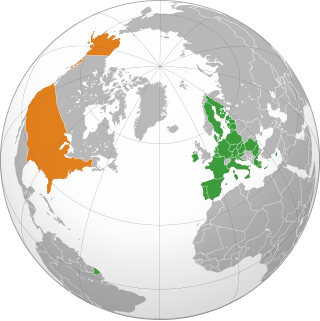
The Transatlantic Trade and Investment Partnership (TTIP) was a proposed trade agreement between the European Union (EU) and the United States, with the aim of promoting trade and multilateral economic growth. According to Karel de Gucht, European Commissioner for Trade between 2010 and 2014, the TTIP would have been the largest bilateral trade initiative ever negotiated, not only because it would have involved the two largest economic areas in the world but also "because of its potential global reach in setting an example for future partners and agreements".
The European Union and Indonesia have built robust commercial relations, with bilateral trade amounting to approximately €25 billion in 2012 resulting in a sizeable €5.7 billion trade surplus for Indonesia with the EU. As of 2012 EU and Indonesia has been marked by an upward trend. Whereas total trade was worth almost €16 billion in 2009, by 2011 it had already reached €23.5 billion.

The Deep and Comprehensive Free Trade Areas (DCFTA) are three free trade areas established between the European Union, and Georgia, Moldova, and Ukraine respectively. The DCFTAs are part of each country's EU Association Agreement. They allow Georgia, Moldova, and Ukraine access to the European Single Market in selected sectors and grant EU investors in those sectors the same regulatory environment in the associated country as in the EU. The agreements with Moldova and Georgia have been ratified and officially entered into force in July 2016, although parts of them were already provisionally applied. The agreement with Ukraine was provisionally applied since 1 January 2016 and formally entered into force on 1 September 2017.

The EU Gateway Programme was an initiative funded by the European Union (EU), created and managed by the Service for Foreign Policy Instruments under the Partnership Instrument. The Programme was launched in 1990 to deepen economic interaction and cooperation between Europe and Japan. After the first successful editions, the Programme expanded into the Republic of Korea, South East Asia and China. For 30 years, until 2020, it acted as a bridgehead to support European companies developing and consolidating their businesses in Asia.

Argentina has strong cultural and historical links to the European Union (EU) and the EU is Argentina's biggest investor.
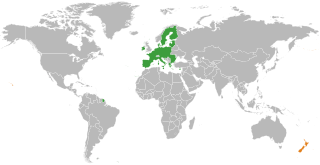
New Zealand and the European Union (EU) have solid relations and increasingly see eye-to-eye on international issues. The EU-New Zealand relations are founded on a Joint Declaration on Relations and Cooperation, first agreed in 2007. It covers not just economic relations, but broader political issues and cooperation.

The EU-Singapore Free Trade Agreement, acronym EUSFTA, is a signed and ratified free trade and bilateral investment treaty between the European Union and Singapore. EUSFTA has been negotiated since March 2010 and its text has been publicly accessible since June 2015. The negotiations on goods and services were completed in 2012, on investment protection on October 17, 2014.

The free trade agreements of Israel represent Israel's cooperation in multinational trade pacts and participation in the global economy. Israel's first free trade agreement was signed in 1985 with the United States of America. Since then, Israel has signed 16 free trade agreements with 48 countries and economic blocks such as the European Union, the European Free Trade Association and Mercosur.

The South Korea–United Kingdom Free Trade Agreement (KUKFTA) is a proposed free trade agreement which began negotiations on 22 November 2023. The trade agreement would be the third FTA to cover South Korea–UK trade, superseding the South Korea–UK Trade Continuity Agreement; extending the deal to cover digital trade. In 2021, 80% of the UK's services exports, in areas from legal advice to management consultancy, were delivered digitally.















